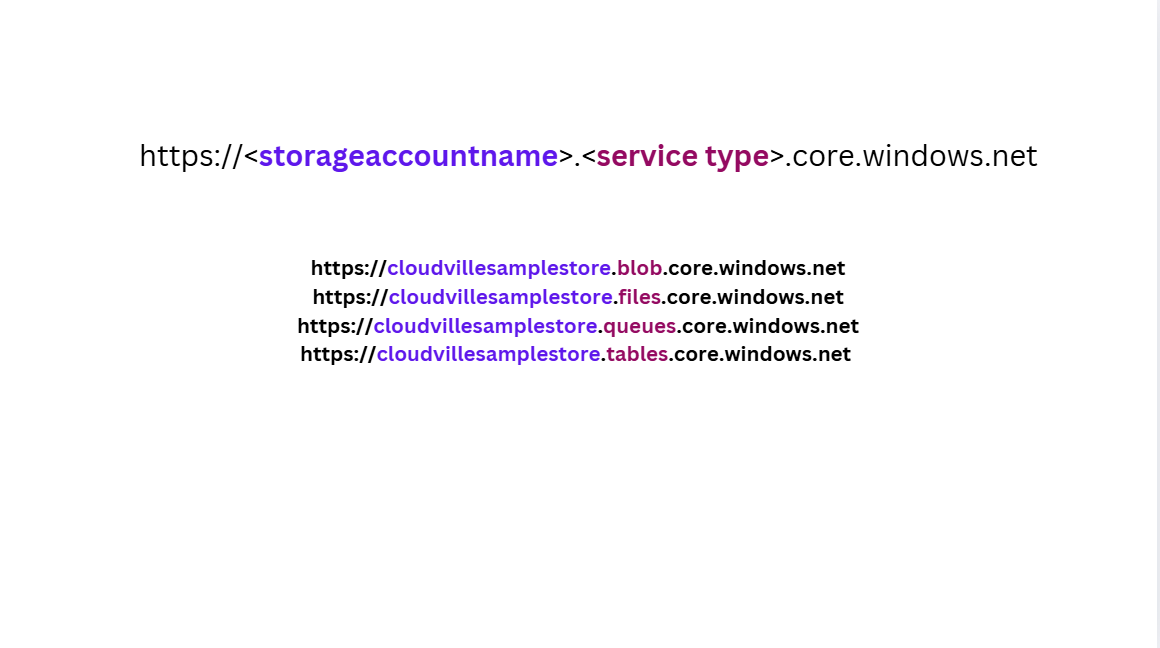AZ-104: Introduction to Azure Storage
 Cloudville
CloudvilleAzure Storage is Microsoft's highly available, secure and massively scalable cloud storage solution designed to cater to modern data storage needs. It is a storage platform that can be used for various data objects in the cloud. These data objects can be accessed globally over HTTP or HTTPS, making it a versatile choice for developers and businesses. Additionally, Azure Storage provides tools like the Azure Portal, Azure PowerShell, Azure CLI, and Azure Storage Explorer for easy interaction and management. Understanding the various components and options of Azure Storage is essential for building real-world cloud solutions (and also passing the AZ-104 exam).
Azure Storage Data Services
Azure Storage comprises several data services, each tailored for specific storage needs. These services include:
Azure Blobs
A scalable object store designed for text and binary data that don’t have any defined structure or (folder) hierarchy. It also supports big data analytics through Data Lake Storage Gen2.
Azure Files
Provides managed file shares that can be accessed both from the cloud and on-premises systems. Here the data follows hierarchy. It supports standard protocols like SMB and NFS.
Azure Queues
A reliable messaging store that facilitates asynchronous communication between application components.
Azure Tables
A NoSQL store that offers schema-less storage for structured data.
Storage Accounts
In order to access (any of) the Azure storage services, you first have to create a “Storage Account”. Within this storage account, you can then choose to have one or all of the services.
The services within a storage account are built for public access by default which is why their names have to be globally unique (i.e. no two storage accounts can have the same name within Azure). It is also why you can access them over the internet using their endpoint URL which usually has a format like this:
https://<storageaccountname>.<service type>.core.windows.net
As an example if we have a storage account named “cloudvillesamplestore”, its endpoints will be as listed below:
https://cloudvillesamplestore.blob.core.windows.net
https://cloudvillesamplestore.files.core.windows.net
https://cloudvillesamplestore.queues.core.windows.net
https://cloudvillesamplestore.tables.core.windows.net

Storage account names can only be between 3 and 24 characters in length and contain numbers and lowercase letters only.

Other significant properties of a storage account include:
Redundancy
This determines how many copies of your data are created and where the copies are stored. The options range from Locally Redundant Storage (LRS) where 3 copies are created and stored within the same datacenter to GZRS (Geo Zone Redundant Storage) where copies are replicated across geographical regions. Redundancy ensures that your data is always available even in the face of failures. You can always consult Microsoft docs to decide on the data redundancy option that suits your purpose.
Types (of Storage Accounts)
Azure Storage offers a variety of storage account types to cater to different needs. Each type supports distinct features and has its own pricing model. Here's a breakdown:
Standard general-purpose v2 (GPv2)
This is the most versatile storage account type, supporting Blob Storage (including Data Lake Storage Gen2), Queue Storage, Table Storage, and Azure Files. It offers a range of redundancy options, including locally redundant storage (LRS), geo-redundant storage (GRS), and more. It's recommended for most scenarios using Azure Storage.
Premium block blobs
This type is optimised for block blobs and append blobs. It's ideal for scenarios with high transaction rates or those that require consistently low storage latency.
Premium file shares
Exclusively for Azure Files, this account type supports both Server Message Block (SMB) and NFS file shares. It's recommended for enterprise or high-performance scale applications.
Premium page blobs
This account type is designed specifically for page blobs.
Legacy storage accounts
While Microsoft doesn't recommend these for most new deployments, they are still supported. The legacy types include the standard general-purpose v1 and Blob Storage accounts. The general-purpose v1 accounts might be suitable for specific scenarios, such as applications requiring the Azure classic deployment model or those that are transaction-intensive.
Performance Tiers
Azure Storage offers two primary performance tiers:
Standard
Suitable for storing infrequently accessed data. It's backed by magnetic drives (HDDs) and offers a cost-effective solution for data that doesn't require high I/O performance. It is the recommended option for most scenarios. All the redundancy options are available when you choose the standard performance tier for your storage account.
Premium
Backed by solid-state drives (SSDs) and designed for high-performance and low-latency workloads. It's ideal for scenarios where quick data access (low latency) is crucial, such as databases or VM disks. When you choose the premium performance tier for your storage account, you will also have to select what “premium account type” you want the storage account to be. Furthermore, the redundancy options will be limited to a choice between LRS and ZRS.
Access Tiers
Azure Storage provides different access tiers to help users store their blob data in the most cost-effective manner based on its usage patterns:
Hot tier
Optimised for storing data that is accessed frequently. It's ideal for data that's in active use or expected to be accessed (read or written) frequently.
Cool tier
Suitable for data that is infrequently accessed and stored for at least 30 days. Examples include short-term backup and older media content not viewed frequently.
Archive tier
Designed for data that will remain in a dormant state for extended periods and can tolerate retrieval latencies. It's the most cost-effective for long-term storage but has higher data retrieval costs.
Each of these tiers has its own pricing model, and transitioning between them can result in cost savings based on the data's lifecycle.
Use Cases
Given the diverse services within Azure Storage, it caters to a wide range of scenarios. Below is a description of what each storage service is ideal for:
Azure Files: Perfect for "lift and shift" cloud migrations where applications already use native file system APIs. It can replace on-premises file servers or NAS devices and can store tools accessible from multiple VMs.
Azure Blobs: Ideal for applications that need to support streaming or random access. It's also suitable for building enterprise data lakes on Azure for big data analytics.
Azure Elastic SAN: Best for large-scale storage interoperable with various compute resources like SQL, MariaDB, Azure VMs, and Azure Kubernetes Services.
Azure Disks: Suitable for "lift and shift" applications that use native file system APIs and for storing data that doesn't need external access.
Azure Queues: Useful for decoupling application components and facilitating asynchronous communication between them.
Azure Tables: Ideal for storing flexible datasets like user data for web applications, address books, or other metadata.
The Microsoft Docs has sample scenarios for Azure Storage services that you can check out. Another one can be found here: Find the Azure storage tools or products you need.
Conclusion
Azure Storage offers a comprehensive suite of services tailored for diverse storage needs. Whether it is storing large datasets, setting up file shares, or managing asynchronous communication in applications, Azure Storage has a solution tailored for various requirements. Understanding the nuances of each of these services and their ideal use cases is crucial in making informed decisions that align with an organisation’s data storage needs, budget constraints and also in optimising their cloud strategy.
Subscribe to my newsletter
Read articles from Cloudville directly inside your inbox. Subscribe to the newsletter, and don't miss out.
Written by
